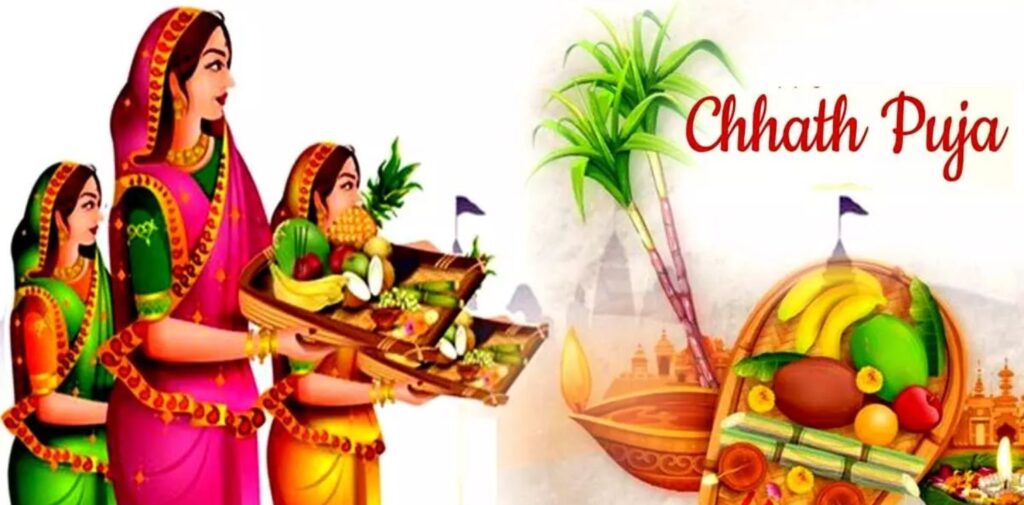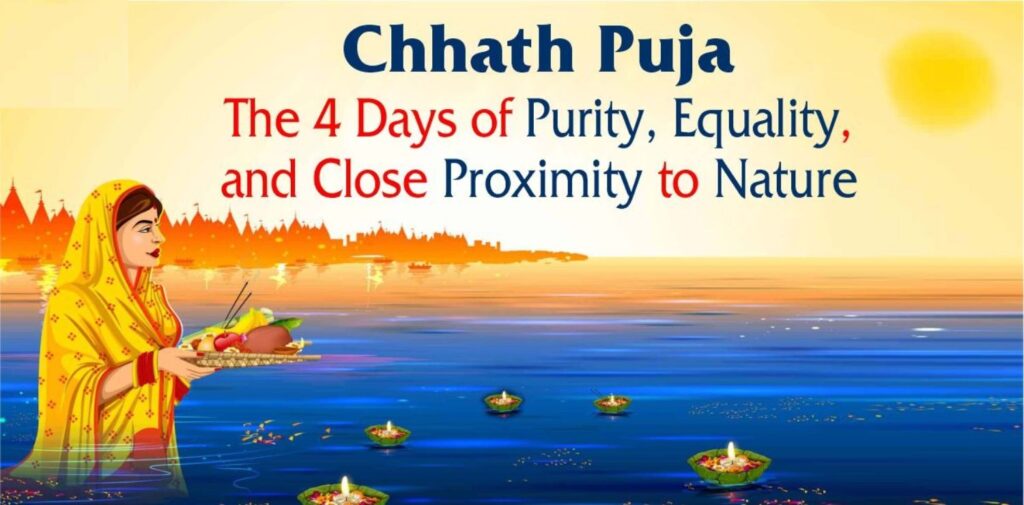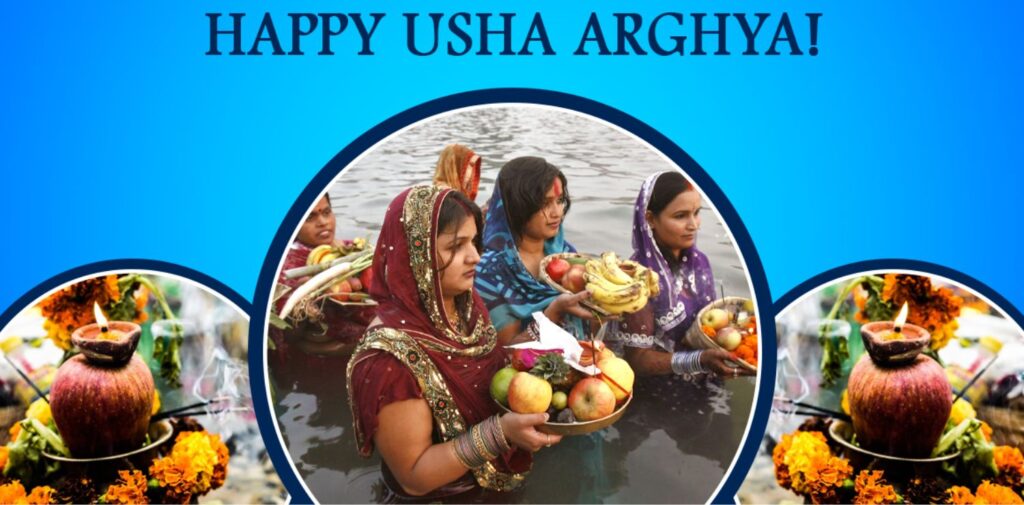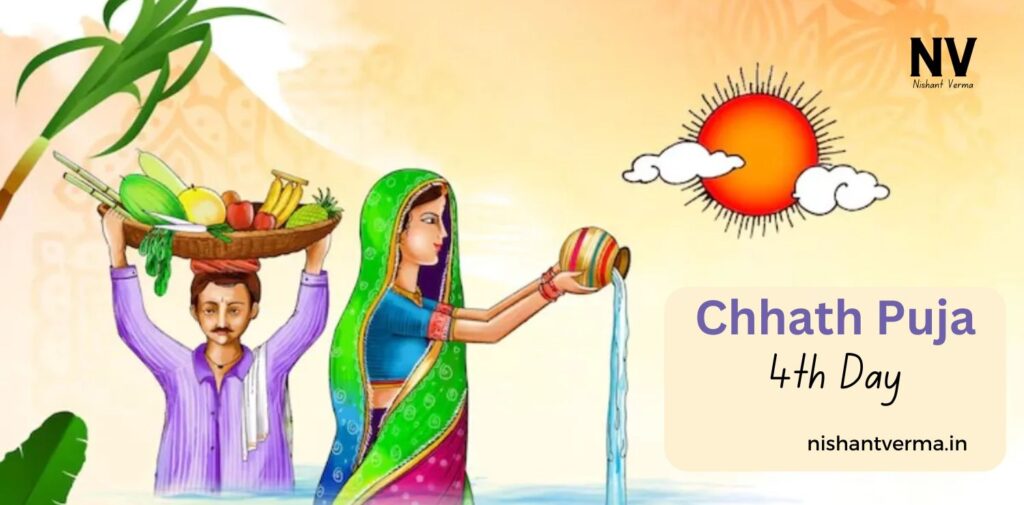Chhath Puja is one of the most significant and vibrant festivals in India, especially celebrated in Bihar, Uttar Pradesh, Jharkhand, and other parts of North India. This ancient festival honours the Sun God, Surya, and his wife Usha. The last day of Chhath Puja is especially important as devotees offer prayers to the rising Sun, seeking blessings for their family, good health, and happiness. This ritual is called “Usha Arghya” or the offering of Arghya to the rising Sun. The fourth day of Chhath Puja is a culmination of several days of intense fasting, prayers, and rituals, and it holds deep spiritual significance.

What is Chhath Puja?
Before diving into the specifics of Usha Arghya, let’s briefly understand what Chhath Puja is all about. Chhath Puja is a festival dedicated to the worship of Surya Dev (Sun God) and his consort Usha, the goddess of dawn. It is primarily observed by Hindus, particularly those from Bihar and eastern Uttar Pradesh. The festival spans over four days, with each day dedicated to specific rituals and prayers.
The essence of Chhath Puja lies in the belief that the Sun God holds the power to bestow good health, prosperity, and protection. People also believe that by observing Chhath Puja, they can seek blessings for their children’s well-being, success, and protection.

The Four Days of Chhath Puja
The festival lasts for four days, and each day has its unique significance:
- Nahay Khay: The first day is about purification. Devotees take a holy dip in the river or any clean water body, followed by the consumption of simple food.
- Kharna: On the second day, devotees fast from sunrise until evening. In the evening, they offer “Kharna,” a ritual meal of kheer (sweet rice pudding) made from jaggery, rice, and milk.
- Sandhya Arghya: The third day is dedicated to the evening offering (Sandhya Arghya) to the setting sun. Devotees stand in water, holding baskets filled with offerings like fruits, flowers, and thekua (a traditional sweet), while they pray to the Sun.
- Usha Arghya: The fourth day is the most significant, as it is the time to offer prayers to the rising Sun. Devotees wake up early, travel to riverbanks or any holy water body, and offer the “Usha Arghya” to the Sun. This marks the end of the Chhath Puja celebrations.
The Importance of Usha Arghya
Usha Arghya is an essential part of Chhath Puja, and it is performed at the break of dawn on the final day of the festival. This ritual holds special significance for several reasons:
- Worship of the Rising Sun: The main purpose of Usha Arghya is to worship the rising Sun. The Sun is seen as the source of life, energy, and power, and offering prayers to the Sun is believed to bring blessings of health, prosperity, and vitality.
- Protection for Children: One of the most important prayers during Usha Arghya is for the protection and well-being of children. Parents pray to Chhatti Maiya (the goddess associated with Chhath) and Surya Dev, asking for their children’s good health, long life, and safety.
- A Prayer for Family’s Happiness: The offerings made during Usha Arghya are also meant for the happiness and peace of the entire family. Devotees seek blessings for prosperity, harmony, and success in their family life.
- Symbol of Gratitude: The act of offering Arghya is also a way to express gratitude to the Sun God for providing life-sustaining energy. It is a humble gesture to acknowledge the role of the Sun in maintaining the balance of nature and supporting all forms of life on Earth.
- Spiritual Cleansing and Renewal: Chhath Puja is a time for spiritual renewal, and the act of standing in water and offering Arghya symbolizes the cleansing of one’s body and soul. It is believed that this purification helps to remove the negative energies and sins accumulated over time.

The Ritual of Usha Arghya
On the fourth day of Chhath Puja, devotees wake up early in the morning, long before sunrise. The first step is to take a holy dip in the river or water body. This is done to purify oneself and to prepare spiritually for the sacred offering. After the bath, they gather their offerings, which typically include:
- Thekua: A traditional sweet made from wheat flour, jaggery, and ghee.
- Fruits: Bananas, coconuts, and other seasonal fruits are included in the offerings.
- Flowers: Marigolds and other fragrant flowers are used to decorate the baskets and symbolize purity.
- Sugarcane: Sugarcane is an important part of the offerings, representing fertility and prosperity.
- Lamps and Diyas: These are lit to offer prayers and light up the surroundings during the ritual.
Devotees, along with their families, gather near the riverbank. Women are often dressed in traditional yellow or red sarees, and they hold the offerings in their hands, carefully balancing them on large plates or baskets. As the Sun starts to rise, the devotees stand waist-deep in the water, facing the Sun.
The person leading the ritual (usually the head of the family) begins chanting prayers, invoking the blessings of Surya Dev. They then offer the Arghya by pouring water and milk into the river while holding the other items aloft. The entire family prays for the health, happiness, and prosperity of their loved ones, with a special emphasis on the well-being of their children.
The ritual is performed with complete devotion, and silence prevails as the Sun rises, marking the end of Chhath Puja.

Significance of Usha Arghya in Today’s World
Usha Arghya has remained a timeless tradition for centuries, but its significance has only grown with time. In today’s fast-paced world, where people are often disconnected from nature and spiritual practices, Chhath Puja, especially the ritual of Usha Arghya, provides a beautiful opportunity for families to come together, reconnect with their roots, and offer gratitude to nature.
The rising Sun symbolizes hope, new beginnings, and the power of the universe to heal and renew. In this way, Usha Arghya also offers a chance for spiritual awakening, rejuvenation, and personal growth. It is a moment of introspection, where individuals reflect on their life’s journey, seek forgiveness, and pray for a better future.
Moreover, the festival promotes the values of simplicity, unity, and togetherness. People from all walks of life, irrespective of their background, join in the celebrations, fostering a sense of community and harmony.
Conclusion
Usha Arghya is the grand finale of Chhath Puja, a sacred moment when devotees offer their prayers and gratitude to the rising Sun. It is a ritual steeped in tradition and devotion, symbolizing the hope for prosperity, protection, and peace for families. Through the simple yet powerful act of offering Arghya, devotees seek the blessings of Surya Dev and Chhatti Maiya for the well-being of their children, their loved ones, and themselves. As the Sun rises, so does the spirit of togetherness, spirituality, and the renewal of faith in the power of the natural world.




